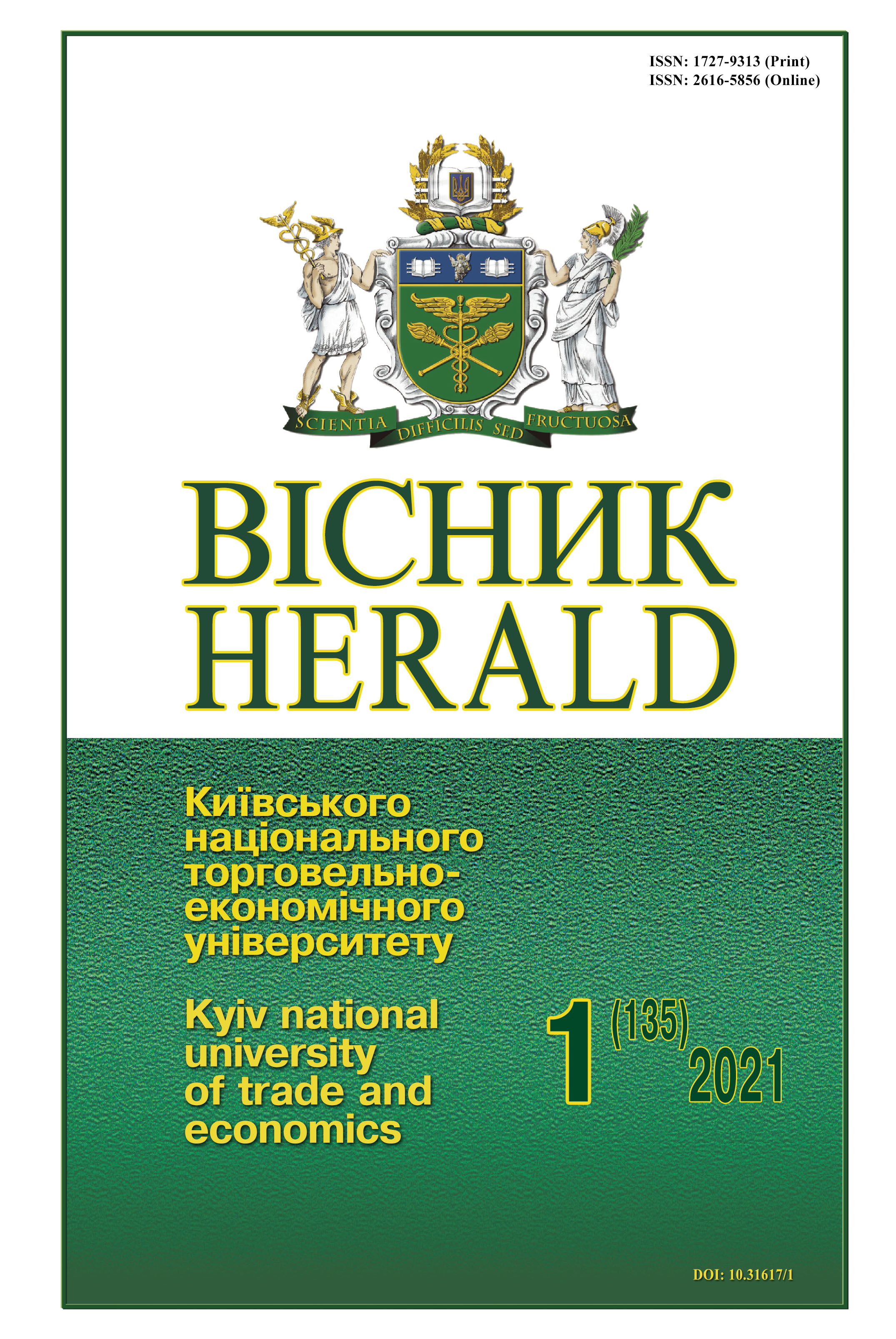Концепт бренда курортно-рекреаційного підприємства
DOI:
https://doi.org/10.31617/visnik.knute.2021(135)04Ключові слова:
бренд, концепт, курортно-рекреаційне підприємство, курортно-рекреаційна послуга, дифузія, дифузний бренд курортно-рекреаційного підприємстваАнотація
Досліджено сутність концепту бренда курортно-рекреаційного підприємства (КРП). Проаналізовано маркетингову активність КРП. Розкрито функціональні атрибути курортно-рекреаційної послуги. Розроблено процес формування дифузного бренда курортно-рекреаційного підприємства.
Посилання
Audenhove, J.-F., Dehaene, M., & Bettati, A. (2020). How do best-in-class B2B players develop customer preference and maximize margins. Retrieved from https://www.adlittle.com/en/insights/viewpoints/commercial-excellence-b2b-environments [in English].
Kunde, J. (2002). Unique; Now or Never: The Brand Drives the Company in the New Value Economy. Рearson [in English].
Boiko, M. H.(2009). Fenomen turyzmu: peredumovy formuvannia tsinnisno oriientovanykh aspektiv upravlinnia [The phenomenon of tourism: prerequisites for the formation of value-oriented aspects of management]. Visnyk DITB –Bulletin of DITB, 13, 19-26[in Ukrainian].
Rogers, E. M. (1995). Diffusion of Innovations, 4th Edition, New York: The Free Press [in English].
Gil, C. (2019). The End of Marketing: Humanizing Your Brand in the Age of Social Media and AI. Kogan Page, Limited [in English].
Coelho, P., & Santos, Р. (2018). On the relationship between consumer-brandidentification,brand community, and brand loyalty. Journal of Retailing and Consumer Services [in English].
Kotler, P., & Keller, K. (2017). Marketing management – 14th ed. Pearson [in English].
Steenkamp, Jan-Benedict (2020). Global Brand Building and Management in the Digital Age. Journal of International Marketing. Retrieved from https://doi.org/10.1177/1069031X19894946[in English].
Foroudi, P. (2019). Influence of brand signature, brand awareness, brand attitude, brand reputation on hotel industry’s brand performance. International Journal of Hospitality Management, 76 (Part A) [in English].
Mazaraki, A., & Melnychenko, S. (2019). National brand of Ukraine.Tallinn: Scientific Route [in English].
Mazaraki, A., Piatnytska, H., & Hryhorenko, O. (2019). Identyfikatsiia kontentu natsionalnoho brendynhu [Identification of national branding content].Visnyk Kyivskoho natsionalnoho torhovelno-ekonomichnoho universytetu–Herald of Kyiv National University of Trade and Economics, 2, 5-33 [in English].
Sushchenko, O. A. (2019). Terytorialnyi brendynh yak instrument rozvytku turystychno-rekreatsiinoho kompleksu [Territorial branding as a tool for the development of tourist and recreational complex]. Ekonomichni innovatsii – Economic innovations. Is. 21,2 (71), 139-149 [in Ukrainian].
Nahorniak, T. L. (2019). Brendynh terytorii yak napriam polityky hlobalnoho, natsionalnoho ta rehionalnoho rivniv [Territory branding as a policy direction at the global, national and regional levels]. Suchasne suspilstvo – Modern society, 2, 77-94 [in Ukrainian].
Pashchenko, O. P., Zakapko, O. I., & Borushchak, N. O. (2020). Teoretychni ta praktychni aspekty brend-menedzhmentu pidpryiemstv restorannoho hospodarstva [Theoretical and practical aspects of brand management of restaurant enterprises]. Pryazovskyi ekonomichnyi visnyk. Elektronne fakhove vydanni – Pryazovskyi economic herald. Electronic scientific journal, 1 (18),126-131. Retrieved from http://pev.kpu.zp.ua/journals/2020/1_18_ukr/25.pdf [in Ukrainian].
Trends in Wellness Tourism (2019). Retrieved from https://www.traveldailynews.asia/trends-in-wellness-tourism-2019 [in English].
Turyzm v Ukraini. (2019). Retrieved from http://www.ukrstat.gov.ua [in Ukrainian].
Michael, F. Otte1, Luiz, G. X. (2016). De Barros What is the Difference Between a Definition and a Concept? Science Journal of Education, 4 (5), 159-168. Retrieved from http://www.sciencepublishinggroup.com/j/sjedu [in English].
Melnychenko, S. V. Brend turystychnoho pidpryiemstva [Brand of a tourist enterprise].er.chdtu.edu.ua/bitstream. Retrieved from https://er.chdtu.edu.ua/bitstream/ChSTU/669/1/ %D0 %9C %D0 %B0 %D1 %82 %D0 %B5 %D1 %80 %D1 %96 %D0 %B0 %D0 %BB %D0 %B8 %2010 %20 %D0 %BA %D0 %BE %D0 %BD %D1 %84 %D0 %B5 %D1 %80 %D0 %B5 %D0 %BD %D1 %86 %D1 %96 %D1 %97_ %D0 %A2 %D0 %BE %D0 %BC %201.pdf#page=18 [in Ukrainian].
Cjohla, S. Ju., Mamontova, O. V. (2006). Osobennosti organizacii i primenenija sistemy kontrollinga na predprijatijah kurortno-rekreacionnogo kompleksa [Features of the organization and application of the controlling system at the enterprises of the resort and recreational complex]. Problemy material’noj kul’tury. Jekonomicheskie nauki, 88, 126-129. Retrieved from http://dspace.nbuv.gov.ua/bitstream/handle/123456789/36606/33[in Russian].
Vedmid, N. I. (2014). Servisne upravlinnia pidpryiemstvamy kurortno-rekreatsiinoi sfery: avtoref. dys. … dokt. ekon. nauk: 08.00.04 – ekonomika ta upravlinnia pidpryiemstvamy (za vydamy ekonomichnoi diialnosti) [Service management of enterprises of the resort and recreational sphere: author’s ref. dis. ... Dr. econ. Sciences: 08.00.04 – economics and management of the enterprises (on kinds of economic activity)]. Kyiv [in Ukrainian].
Yarmak, V. (2018). Poniattia brendu ta yoho spivvidnoshennia z poniattiam torhovelnoi marky [The concept of brand and its relationship with the concept of trademark]. Problemy zakonnosti – Problems of legality, 141, 214-222 [in Ukrainian].
Schoppen, H. S. (2017). The Impact of Brands on People, Markets and Society: Build Bridge Bond Method for Sustainable Brand Leadership. Retrieved from https://www.rug.nl/ research/portal/files/54951193 [in English].
Preissl, B. (1995). Strategic use of communication technology – diffusion processes in networks and environments. Information Economics and Policy, 75-96 [in English].
Bass, F. M. (1980). The Relationship between Diffusion Rates, Experience Curves, and Demand Elasticities for Consumer Durable Technological Innovations. Journal of Business, 53 (2), 51-67 [in English].
Horsky, D. (1990). The efects of income, price and information on the diffusion of new consumer durables. Marketing Science, 9, 342-365 [in English].
Kalish, S. A. (1985). New Product Adoption Model with Pricing, Advertising, and Uncertainty. Management Science, 31, 1569-1585 [in English].
Mahajan, V., Bass, F. M., & Muller, E. (1979). Innovation diffusion and new product growth models in marketing. Journal of Marketing, 55-68 [in English].
Majority of Majority of Millennials prefer shopping in stores. insights.retailenvironments.org. Retrieved from https://insights.retailenvironments.org/2016/12 [in English].
Kaplan, A., & Haenlein, M. (2010). Users of the world, unite! The challenges and opportunities of Social Media. Business Horizons, 53(1), 59-68 [in English].
Larson, K., & Watson, R. (2010). The value of social media: toward measuring social media strategies. In Proceedings of the ICIS. 1-18. Shanghai. China [in English].
MisganawAssegid Ayele, SinghApar(2020). The Diffusion of E-marketing in Tourism Businesses of Ethiopia: An Empirical Investigation of Organisational E-readiness Perspectives: European Journal of Tourism Hospitality and Recreation, 10(1).1-13. Retrieved from https://www.researchgate.net/publication/342903829_The_Diffusion_of_E-marketing_in_Tourism_Businesses_of_Ethiopia_An_Empirical_Investigation_of_Organisational_E-readiness_Perspectives [in English].
Brand Diffusion. In: Management Mania. Wilmington (DE) 2011–2020. Retrieved from https://managementmania.com/en/brand-diffusion [in English].
Hudson, S. (2017). Marketing for Tourism, Hospitality & Events: A Global & Digital Approach. SAGE Publications. Delhi [in English].
Parker, P., Gatignon, H. (1994). Specifying competitive effects in diffusion models: an empirical analysis. International Journal of Research in Marketing, 17-39 [in English].
Liu, S. C., Choi, T. M., Hui, C. L. (2011). A study on individual tourists from the Chinese mainland to Hong Kong: implications for tourism marketing in fashion. Tourism Economics. Vol. 17, 1287–1309 [in English].







